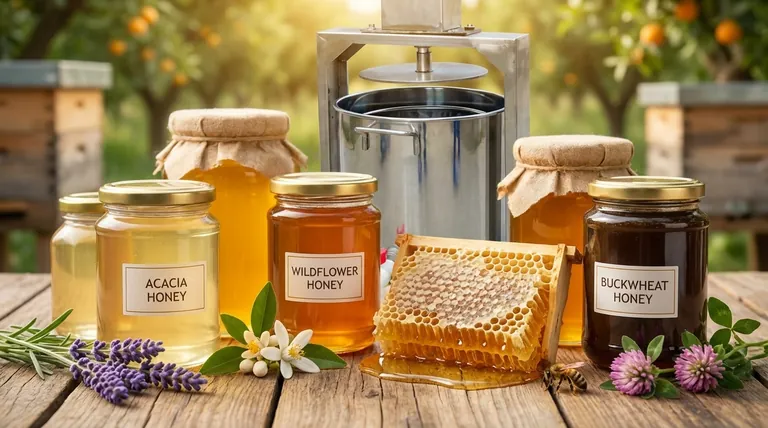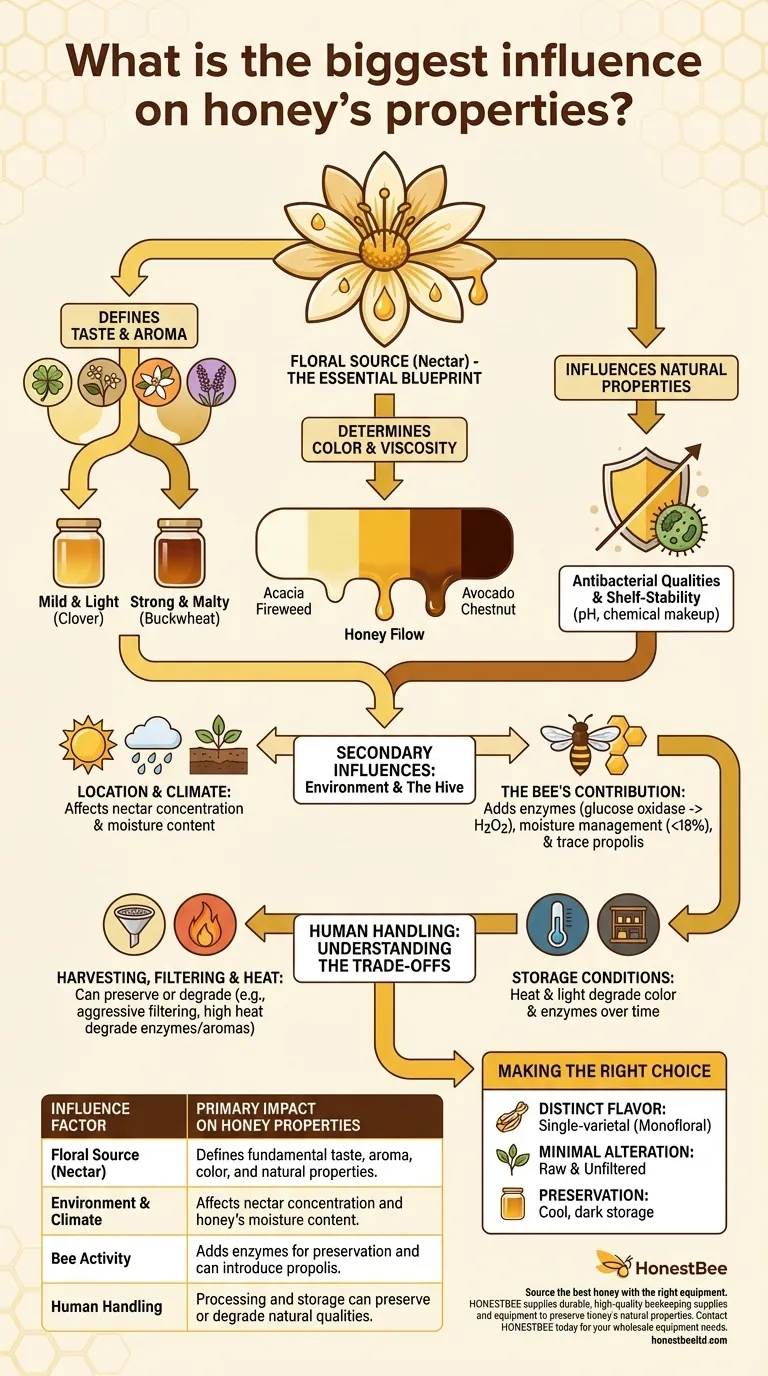Without question, the single biggest influence on a honey’s properties is its floral source. The specific type of flower nectar that bees gather fundamentally determines the honey's resulting taste, color, aroma, and texture.
While many factors from climate to post-harvest handling play a role, the nectar's origin is the essential blueprint for a honey's character. All other influences—environmental, apian, and human—act upon this initial foundation.

The Floral Blueprint: Why Nectar Source is Paramount
The journey from a flower to a jar of honey begins with nectar. The unique chemical composition of that nectar, which varies dramatically between plant species, is the primary driver of the final product's characteristics.
Defining Taste and Aroma
Different flowers produce nectars with distinct profiles of sugars, acids, and aromatic compounds. This is why clover honey is mild and light, while buckwheat honey is strong, earthy, and malty. The flower is the source of the honey's signature flavor.
Determining Color and Viscosity
The nectar source also dictates the honey's appearance. Nectars from flowers like acacia or fireweed produce a water-white honey, whereas nectars from avocado or chestnut blossoms result in a dark, molasses-like color.
Influencing Natural Properties
A honey's natural antibacterial qualities and shelf-stability are also linked to its origin. The bees themselves add enzymes, but the nectar's initial pH and chemical makeup contribute significantly to the honey's overall preservative power.
Secondary Influences: Environment and the Hive
While the floral source sets the stage, other factors in the honey's creation process can modify its final properties. These are secondary but still significant influences.
The Role of Location and Climate
A beehive’s broader environment—including temperature, soil, and rainfall—affects which plants thrive and the concentration of their nectar. A rainy season can lead to a lighter, runnier honey, as the nectar collected will have a higher water content.
The Bee's Contribution
Honey bees are not passive carriers. They add a crucial enzyme, glucose oxidase, which helps create hydrogen peroxide. This is a key component of honey's natural antibacterial properties. Traces of propolis (a resinous hive sealant) can also get mixed in, adding to the honey's unique profile.
The Importance of Moisture Content
Bees actively manage the honey's moisture content within the hive, fanning their wings to dehydrate the nectar to below 18%. This low moisture level is critical for preventing fermentation and ensuring the honey remains stable for years.
Understanding the Trade-offs: The Impact of Human Handling
Once the honey leaves the hive, human intervention becomes the next major influence. How honey is harvested, processed, and stored can either preserve or degrade the properties endowed by the flower and the bee.
Harvesting and Filtering Methods
The method used to extract honey can introduce foreign matter. Consequently, most honey is filtered to remove beeswax and other debris. However, aggressive filtering can also remove beneficial pollen and propolis particles, altering the honey's texture and nutritional profile.
The Effect of Heat
Some commercial processing involves heating honey to make it less viscous for easier bottling and to slow down natural crystallization. The trade-off is that heat can degrade the delicate enzymes and aromas that make each honey unique.
Storage Conditions
Exposure to heat and light during storage will degrade honey over time. It can darken the color and diminish the activity of its natural enzymes, slowly altering the properties it had when first harvested.
Making the Right Choice for Your Goal
Understanding what influences honey allows you to select the right product based on what you value most.
- If your primary focus is distinct flavor: Seek out single-varietal (monofloral) honeys, where the taste of a specific flower like orange blossom or lavender is the star.
- If your primary focus is minimal alteration: Look for products labeled "raw" and "unfiltered" to get a honey that is closest to its state in the hive, complete with pollen.
- If your primary focus is preservation: Store any honey in a cool, dark pantry. This simple step protects the delicate enzymes and aromas from degradation.
By recognizing honey as a complex product of a specific place and process, you can better appreciate its remarkable diversity.
Summary Table:
| Influence Factor | Primary Impact on Honey Properties |
|---|---|
| Floral Source (Nectar) | Defines fundamental taste, aroma, color, and natural properties. |
| Environment & Climate | Affects nectar concentration and honey's moisture content. |
| Bee Activity | Adds enzymes for preservation and can introduce propolis. |
| Human Handling | Processing and storage can preserve or degrade natural qualities. |
Source the best honey with the right equipment.
For commercial apiaries and beekeeping equipment distributors, the quality of your honey starts with the floral source, but it's protected by professional harvesting and processing. HONESTBEE supplies the durable, high-quality beekeeping supplies and equipment you need to harvest, process, and store honey while preserving its unique, natural properties. Ensure your honey retains the distinct character defined by its origin.
Contact HONESTBEE today to discuss your wholesale equipment needs and elevate your honey production.
Visual Guide

Related Products
- 10L Stainless Steel Electric Honey Press Machine
- HONESTBEE 3-Frame Manual Acrylic Honey Extractor
- 24 Frame Honey Extractor Commercial Radial Honey Frame Extraction Machine
- Natural Wood Honey Dipper for Tea Coffee and Desserts
- Plastic Hand Crank 2 Frame Honey Extractor Low Price
People Also Ask
- How does pressed honey compare to extracted or crush-and-strain? Unlock the Full Flavor of the Hive
- What are the key features of a honey press? Maximize Yield with Durable, Efficient Extraction
- How does the press method for extracting honey work? A Simple, Low-Cost Guide for Beekeepers
- What voltage options are available for stainless steel screw honey pumps? Choose the Right Power for Your Scale
- What happens to the wax after pressing in a honey press? A Guide to Maximizing Your Hive's Yield



















